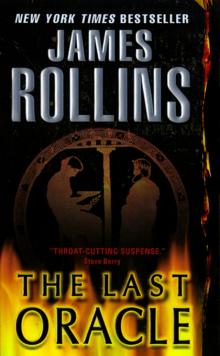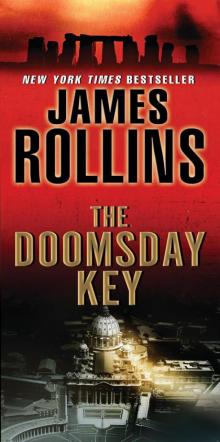- Home
- James Rollins
Sigma Guide
Sigma Guide Read online
THE
SIGMA FORCE
DOSSIER
Compiled by Special Analyst Greg Cox
PRIORITY
CLEARANCE
REQUIRED
CONTENTS
Introduction
What Is Sigma Force?
Operative Profiles
Allies and Enemies
Case Histories
Facing the Future
INTRODUCTION
Welcome to Sigma Force. You have been recruited to assist Sigma, a top-secret arm of the Defense Advanced Research Projects Agency (DARPA), in its ongoing mission to investigate and secure dangerous new (or ancient) technologies that may impact the national security of the United States. The following information, which is strictly classified, is intended to provide you with the necessary background to fully comprehend Sigma’s past, present, and future operations. In some instances, particularly sensitive pieces of information have been [REDACTED] in the interests of security and/or diplomacy. This intel can only be found in the complete case histories by chief archivist and historian James Rollins.
[Note: the contents of this dossier are not to be shared with suspected members of The Guild or any other terrorist organizations.]
For convenience’s sake, certain crucial missions have been assigned codenames and abbreviations as follows:
Sandstorm (abbreviated “SS”).
Map of Bones (MOB)
Black Order (BO)
“Kowalski’s in Love” (KiL)
The Judas Strain (TJS)
The Last Oracle (TLO)
The Doomsday Key (TDK)
“The Skeleton Key” (TSK)
The Devil Colony (TDC)
Bloodline [BL]
Concise summaries of each mission appear in Section 4 of this dossier.
1
WHAT IS SIGMA FORCE?
In mathematics, the Greek letter Σ (sigma) represents the sum of all parts, the unification of disparate sets into a whole, but, unknown to the world at large, it is also the emblem for a very special organization. Sigma operates as the covert military arm of DARPA, the Defense Department’s high-tech research and development division. Sigma’s primary objective is search and seizure: responding with surgical precision to obtain, protect, or neutralize potentially dangerous new research and discoveries. In a world where the slightest edge in technology can be the difference between victory and disaster, Sigma Force works to maintain of the technological superiority of the United State of America—at all costs.
To carry out its mission, Sigma employs ex-Special Forces operatives, often with genius IQ’s, who are handpicked in secret and put through rigorous doctoral programs to give them the technical know-how to function in the field as both brain and brawn. Or, as Sigma agents are sometimes described, “scientists with guns.”
The idea behind Sigma was first conceived by the Jasons, a scientific think tank formed back during the Cold War. Leaders in many fields, including several Nobel winners, met regularly to advise the U.S. military on scientific matters and brainstorm new tactical innovations. It was at one such meeting that Archibald Polk, a noted professor of neurology, suggested the formation of a militarized team of investigators to act as field agents for DARPA. (In a curious twist, Polk’s daughter Elizabeth is currently dating Sigma operative Joe Kowalski.) Polk’s brainchild was implemented and made reality by Sean McKnight, who founded Sigma Force and personally recruited its first agents, including Painter Crowe, who later took Sean’s place as director of Sigma Force. Painter remains in charge to this day.
Sigma’s headquarters were originally located in Arlington, Virginia, a few miles from the Pentagon, but after Sigma was infiltrated by the Guild, Painter had Sigma Command moved to a more secure and convenient location: beneath the Smithsonian Castle on the National Mall in Washington, D.C. Built in 1847, the imposing Gothic Revival structure was the first Smithsonian building and boasts anachronistic red sandstone towers, spires, and battlements, making it a literal fortress. Officially known as the Smithsonian Institution Building, “the Castle” currently houses the Smithsonian’s administrative offices and visitor center. Unknown to the many tourists who visit the Castle, however, the old WWII-era bomb shelters beneath the building have been converted into Sigma’s top-secret command center.
The location was picked for its convenient access to both the halls of power and the Smithsonian’s many museums and research facilities. It would have been too expensive (and redundant) to duplicate all of the Smithsonian’s varied facilities, which cover a wide range of disciplines, so many of Sigma’s members work at laboratories throughout the Smithsonian, which has become both a resource and a cover.
Sigma’s own subterranean warren include offices, laboratories, a communications nest, a fully-equipped medical unit, a morgue, pathology suites, detention cells, and even a gym and locker rooms. The director’s office features three large wall-mounted plasma screens that serve as his windows on the world. The main conference room, built after a fire-bombing damaged the original facilities [TLO], features a circular table with computer stations before each seat. The table can accommodate up to a dozen people. Painter personally designed the conference room so that he would have room enough to pace around the table and observe those gathered around it.
The satellite surveillance com is the nerve center of Sigma Command. Lit only by a circular bank of monitors and glowing computer screens, it resembles the control room of a nuclear submarine, with the ambient light kept low to preserve night-vision. All information flows in and out of an interconnected web of feeds from both domestic and foreign intelligence agencies.
Protocol Alpha, a sophisticated fail-safe measure, protects Sigma’s secrets in the event of an attack by a hostile force, as has happened on at least one occasion [TLO]. A gaseous accelerant is fed into the air supply, achieving critical levels within fifteen minutes, at which point the automated system ignites sparks throughout the base, triggering a firestorm across all levels of Sigma Command. The flash fire lasts only seconds, searing every surface within the concrete bunkers, before sprinklers douse the flames immediately. It is hoped that this protocol will never need to be implemented again, but Sigma is prepared, just in case.
Σ
Sigma operates under the auspices of DARPA, the Defense Advanced Research Projects Agency: a research-and-development arm of the Defense Department. Established in 1958 in response to the Soviet Union’s launch of Sputnik into space, DARPA funds cutting-edge research across a wide range of fields, from robotics to aerospace to biological warfare defenses to the latest in artificial intelligence and information technology. Their goal: creating and preventing strategic surprise. Or, more bluntly, get there first.
DARPA is based in Arlington, Virginia, which was home to Sigma Command as well, before Sigma relocated to Washington, D.C. In order to evolve with the times and the challenges of a changing world, DARPA has frequently restructured itself. At present, the agency is comprised of six “official” divisions: the Defense Sciences Office, the Information Innovation Office, the Microsystems Technology Office, the Strategic Technology Office, and the Tactical Technology Office. Each office acts as an umbrella for the various areas of focus under its respective purview.
Current projects include efforts to develop an unmanned anti-submarine warfare vessel, an acoustic gunshot detection system designed to locate snipers, a high-energy laser defense system, a battery-powered human exoskeleton, advanced infrared rifle scopes, virtual reality contact lenses, a revolutionary new fire suppression method, promising new counter-measures for radiation poisoning, new cyber-security defenses, innovative high-pressure materials, a legged robot (nicknamed “Cheetah”) capable of galloping at speeds of up to eighteen miles per hour, and even a thought-
operated prosthetic limb not unlike the one worn by Sigma agent Monk Kokkalis. DARPA also sponsors a variety of competitions designed to foster high-tech innovation and creativity, such as the DARPA Grand Challenge, in which driverless robotic vehicles compete for a cash prize.
In these and other ambitious endeavors, DARPA strives to anticipate future threats and opportunities in order to ensure that America is never caught off-guard by revolutionary new discoveries—and that its enemies will be. More information about DARPA’s current initiatives can be found at their official website: www.darpa.mil.
This website makes no mention of Sigma Force, which remains a closely-guarded secret even within DARPA. Only a handful of highly-placed individuals are aware of Sigma’s existence, including the President, the Joint Chiefs of Staff, and the current director of DARPA: General Gregory Metcalf.
Σ
The Guild is Sigma’s dark shadow and recurring nemesis. Although Sigma’s operations have brought them into conflict with a variety of criminal and terrorist organizations, including the Imperial Dragon Court [MOB], neo-Nazis [BO] , and former KGB agents [TLO], the Guild remains Sigma’s most persistent—and enigmatic—adversary. Painter Crowe has made ferretting out the true origins and objectives of the Guild his top priority.
The full extent of the threat posed by the Guild has only gradually come to light, and much remains unknown—including the true name of the organization. “The Guild” is just a convenient nickname for a secret society whose actual name (if any) is known only to its shadowy leaders. As far as Sigma knows, the term was first coined by a now-deceased British SAS officer who had a run-in with the group. The name was later adopted (mockingly?) by Guild operatives, who are deliberately kept in the dark as to their own leadership. The Guild patterns its structure on terrorist cells; information is passed between teams on a strictly need-to-know basis, with each cell under independent authority, answerable only to the upper Echelon, whose identities are fiercely guarded—even from their own people. Global in scope, the Guild has moles planted in governments, intelligence agencies, think tanks, universities, and research facilities throughout the world, all the better to seize control of any valuable new discoveries.
To carry out its objectives, the Guild employs handpicked mercenaries with Special Forces experience. Drummed out of the Forces, most of these soldiers could now be found in various mercenary and paramilitary groups throughout the world, where they had grown harder and more ruthless. Like Sigma Force, the Guild recruits only the smartest and most resourceful warriors, but, unlike Sigma, the Guild has another crucial criterion: its soldiers need to have no qualms about killing—or torture.
Σ
Sigma’s understanding of the Guild has deepened over the years. In the beginning, they were only a whisper. When Painter Crowe first encountered them during his quest for the lost city of Ubar, he believed them to be nothing more than an international criminal network born from the ashes of the former Soviet Union and run by an unholy alliance of Russian mobsters and ex-KGB agents. Little was known about them except that they were merciless, well-funded, and apparently driven by profit, not ideology. Competing with Sigma, they hunted and stole emerging technologies—military, biological, chemical, nuclear—and sold them to the highest bidder, including Al Qaeda and Hezbollah in the Middle East, Aum Shinrikyo in Japan, and the Shining Path in Peru. Painter was shocked to discover that the Guild had even planted moles in DARPA—and Sigma [SS].
Upon taking command of Sigma, Painter spent his first eight months restructuring the organization and shoring up security in order to keep it from being compromised again. As there had been no way of telling what intel had been gleaned, sold, or spread by the Guild, everything had to be purged and rebuilt from scratch. Not until Painter was confident that Sigma was secure did he start sending agents out into the field again, where they immediately crossed paths with the Guild once more.
An investigation into the theft of sacred relics found a Guild assassin, Seichan, playing various factions against each other for her own purposes. At the time, the Guild’s interest in the matter appeared to be strictly mercenary; Sigma eventually discovered that the Guild had been hired by [REDACTED] to infiltrate an ancient enemy. The Guild, it was reported, were ruthless, but they were also efficient, honored their contracts, and got the job done—by any means possible. As far as anyone knew, the Guild’s only motives were wealth and power [MOB].
Roughly a year later, the Guild opted out of the “Darwin Bible” affair. It is unclear why they considered this matter riskier than their earlier campaigns, if that was truly the reason they declined to get involved [BO].
Not long after, a shadowy terrorist organization funded research into a dangerous transgenic rabies virus which was tested on a remote Indian village in Brazil. There is reason to suspect that this organization was the Guild, although they kept a fairly low profile in that affair [KiL].
By contrast, the Guild was more aggressive than ever in their pursuit of an ancient virus—and its cure. The so-called “Judas Strain” brought the Guild directly into conflict with Sigma Force, with casualties on both sides. Much of the conflict played out in Southeast Asia, where the Guild was found to have deep ties in China and North Korea [TJS].
Fourteen months later, the Guild and Sigma clashed once more over a long-lost biological weapon. It was evident that the Guild was fixated on forgotten knowledge and science, particularly of ancient Egypt origins. During this operation, [REDACTED] was exposed as part of “Echelon,” the elusive puppet-masters behind the Guild. Painter also discovered that Echelon members bore a cryptic tattoo at the back of their skulls, although the meaning of the symbol, which resembled [REDACTED] remained obscure [TDK].
By now, Painter had come to suspect that the Guild was more than just an international syndicate out to profit from the sale of stolen technology. His fears deepened when [REDACTED] provides him with evidence that the Guild dates back to the birth of America—and beyond. When the Guild resurfaces in pursuit of long- buried nanotechnology, even more ominous clues arise regarding their true origins [TDC]. Painter now has reason to believe that, rather than merely being the mutant offspring of the Soviet Union as he first believed, the Guild may actually be controlled by a small group of aristocratic families who have been accumulating wealth, power, and influence over the centuries—or millennia. And that one of those families, possibly the last surviving “True Bloodline,” is nestled deep within American history and politics, making it all but impossible to uproot.
Many mysteries remain about the Guild’s ultimate nature and agenda, and some of Sigma’s theories about this relentless foe have yet to be confirmed, but one thing seems certain.
A war is coming.
2
OPERATIVE PROFILES
The following profiles contain background info and biographical data on key personnel. Due to the hazards and complications of the job, this data is subject to dramatic (and sometimes terminal) changes at any moment.
CROWE, PAINTER
Current rank: Director, Sigma Force.
Background: Navy Seal.
Specialties: micro-surveillance and computer engineering.
Physical description:
Black hair. Ice-blue eyes. Broad shoulders. The granite planes of Painter’s face betray his partial Native American heritage. Tanned and sporting brown contact lenses, he can pass for a full Native American, but long hours working in Sigma’s underground command center have taken a toll on his tan in recent years. A streak of white hair over one ear is a souvenir of a near brush with death [BO]. In his forties, he is about a decade older than most of his agents.
History:
Painter’s father, Jolon, was a Pequot Indian, raised on the Mashantucket reservation in Connecticut, who eventually abandoned the reservation to seek his fortune in New York City, where he met and married a fiery Italian woman named Isabella, who sadly suffered from depression. An unhappy marriage led to a drinking problem, but Jolon sometimes
took his young son hunting on tribal lands, where Painter learned how to bait a trap and lure prey, skills that would prove valuable in his later career. The elder Crowe also taught his son a few Pequot chants in a feeble attempt to pass on some tribal traditions. Painter learned the chants, whispering them to himself while his parents fought, and still uses them to focus his mind and calm his spirit, despite not knowing or caring what they mean. His parents’ troubled marriage came to a violent end when, seven years after Painter’s birth, Isabella stabbed Jolon to death. With his mother on Death Row, Painter grew up in a series of foster homes where he quickly learned it was best to keep silent and stay unseen. Over the years, Painter has maintained loose connections to his father’s tribe and tangled extended family, but has come to think of himself as more American than Native-American.
Distinguishing himself as a Navy Seal, Painter broke his leg during a mission in Iraq. While recuperating, he was recruited into Sigma by Sean McKnight, who taught him the value of honing his mind as well as his body, and who put Painter through a grueling academic boot camp that made his Navy Seal training seem easy by comparison. Painter became one of the very first Special Forces veterans recruited for Sigma. His specialized training has allowed him to develop various high-tech devices employed by Sigma operatives, including subdermal transceivers capable of tracking persons of interest without their knowledge, miniature electronic bugs the size of grains of rice, and night-vision goggles (hooked up to parabolic mikes) that can record up to an hour of digital surveillance footage.
Painter served as a field agent for several years before replacing McKnight as director of Sigma Force when his mentor was promoted to head of DARPA [SS]. Although he has successfully guided Sigma through numerous crises, Painter often chafes at not being in the field himself--and wishes that his subterranean office had a window. Following the tragic death of Sean McKnight, Painter was offered the post of director of DARPA by the President himself, but chose to remain in charge of Sigma in order to provide continuity of leadership during a challenging time [TLO]. He occasionally suffers from migraines and heartburn.

 The Skeleton Key
The Skeleton Key The Last Oracle
The Last Oracle The Judas Strain
The Judas Strain Black Order
Black Order Sandstorm
Sandstorm Ghost Ship
Ghost Ship The Devil Colony
The Devil Colony Subterranean
Subterranean The Doomsday Key
The Doomsday Key The 6th Extinction
The 6th Extinction Bloodline
Bloodline Jake Ransom and the Howling Sphinx
Jake Ransom and the Howling Sphinx The Midnight Watch
The Midnight Watch Map of Bones
Map of Bones The Demon Crown
The Demon Crown Deep Fathom
Deep Fathom Sigma Guide
Sigma Guide Kowalski's in Love
Kowalski's in Love Jake Ransom and the Skull King's Shadow
Jake Ransom and the Skull King's Shadow Excavation
Excavation The Seventh Plague
The Seventh Plague Altar of Eden
Altar of Eden Unrestricted Access: New and Classic Short Fiction
Unrestricted Access: New and Classic Short Fiction Indiana Jones and the Kingdom of the Crystal Skull
Indiana Jones and the Kingdom of the Crystal Skull Crucible
Crucible The Eye of God
The Eye of God The Bone Labyrinth
The Bone Labyrinth The Last Odyssey: A Thriller
The Last Odyssey: A Thriller Unrestricted Access
Unrestricted Access Amazonia
Amazonia Blood Brothers: A Short Story Exclusive
Blood Brothers: A Short Story Exclusive Map of Bones: A Sigma Force Novel
Map of Bones: A Sigma Force Novel The Skeleton Key (sigma force)
The Skeleton Key (sigma force) Sigma Force 10 - The Sixth Extinction
Sigma Force 10 - The Sixth Extinction Innocent Blood
Innocent Blood Map of Bones sf-2
Map of Bones sf-2 The Eye of God: A Sigma Force Novel
The Eye of God: A Sigma Force Novel The Eye of God: A Sigma Force Novel sf-9
The Eye of God: A Sigma Force Novel sf-9 The Pit
The Pit Indiana Jones and the The Kingdom Of The Crystal Skull
Indiana Jones and the The Kingdom Of The Crystal Skull The Last Oracle (2008) sf-5
The Last Oracle (2008) sf-5 City of Screams
City of Screams The Doomsday Key and The Last Oracle with Bonus Excerpts
The Doomsday Key and The Last Oracle with Bonus Excerpts The Judas Strain sf-4
The Judas Strain sf-4 Blood Infernal
Blood Infernal The Demon Crown: A Sigma Force Novel
The Demon Crown: A Sigma Force Novel War Hawk: A Tucker Wayne Novel
War Hawk: A Tucker Wayne Novel SANDSTORM sf-1
SANDSTORM sf-1 Bloodline: A Sigma Force Novel
Bloodline: A Sigma Force Novel Amazonia: a novel
Amazonia: a novel The Last Oracle: A Sigma Force Novel
The Last Oracle: A Sigma Force Novel City of Screams (the order of the sanguines)
City of Screams (the order of the sanguines) Ghost Ship: A Sigma Force Short Story
Ghost Ship: A Sigma Force Short Story The Doomsday Key: A Sigma Force Novel
The Doomsday Key: A Sigma Force Novel